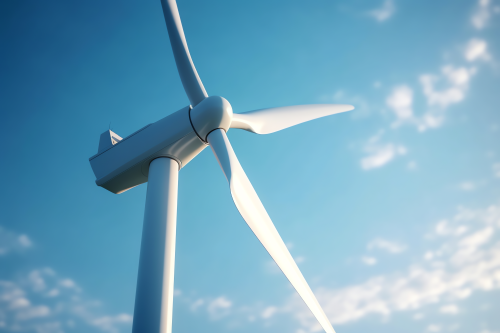· clean energy · 4 min read
Residential Wind Turbines for Home Energy
Explore the resurgence of residential wind turbines as a viable alternative energy source. This article sheds light on the benefits and practical considerations of harnessing wind power for home energy

In the wake of the Inflation Reduction Act, residential wind turbines are gaining momentum. These compact, efficient devices harness the kinetic energy of the wind, transforming it into practical electrical power. They offer homeowners a path to energy self-sufficiency, alleviating grid strain, and contributing to environmental conservation. With incentives like the Residential Clean Energy Credit, the economic viability of residential wind turbine installations becomes even more appealing. This article explores the essentials, integration, benefits, challenges, and the future of residential wind turbines.
The Basics of Residential Wind Turbines
Residential wind turbines function similarly to commercial ones but on a smaller scale. The rotor blades capture the wind’s power, while the hub, main shaft, gearbox, and generator work together to produce electricity efficiently. The design and technology behind wind turbines have evolved, making them more accessible to homeowners. For a comprehensive understanding, the Department of Energy provides an interactive animation of a wind turbine.
Assessing Your Property for Wind Energy
Before installing a home wind turbine, it’s essential to evaluate your property’s suitability for wind energy. Here are some key factors to consider:
Wind Resources Assessment: Understanding the wind resources in your area is crucial for optimal power generation. Wind mapping and site analysis can help you determine if your location is suitable for a wind turbine.
Site Selection: Choosing the right site for your residential wind turbine is vital. Factors such as elevation, obstructions, and proximity to neighbors can affect the wind turbine’s efficiency.
To understand if your home is a good candidate for a home wind turbine, check out out article on residential wind assessment.
Consideration of how the wind turbine will integrate with your existing power system, including potential battery storage, is essential for a seamless operation.

Merging Wind Power with Your Home’s Electrical Grid
Integrating residential wind turbines with a home’s power system can reduce dependence on fossil fuels, lower energy bills, and alleviate grid pressure. Proper installation and connection enable wind-generated electricity to power various home appliances, and excess energy can be stored in a battery. This integration represents a step towards a more sustainable and resilient energy future. Learn more about energy storage at Home Energy Storage.
Hybrid Wind/Solar Systems: A Consistent and Reliable Power Supply
A hybrid wind/solar system is a forward-thinking solution that combines the strengths of wind and solar energy. By harnessing the power of the sun during the day and the wind at night, this system ensures a consistent and reliable power supply for your home. When one source is less available, the other compensates, providing energy even in varying weather conditions. This synergy not only enhances energy efficiency but also contributes to grid stability, alleviating peak demand pressures. For an in-depth exploration of hybrid systems, check out our article on Solar and Wind Hybrid Systems.
Other Key Factors to Consider
Cost and Incentives: Understanding the costs involved in installation and maintenance, as well as available incentives like the Residential Clean Energy Credit, will help you evaluate the economic viability of the project.
Permits and Regulations: Compliance with local regulations regarding turbine height, noise levels, and setbacks is mandatory. Obtaining the necessary permits ensures that your installation adheres to community standards and legal requirements.
Environmental Considerations: Assessing potential environmental impacts, such as effects on birds and bats, is part of responsible planning.
Conclusion
The rise of residential wind turbines reflects our growing commitment to renewable energy and sustainability. As homeowners seek innovative ways to reduce their environmental impact and enhance energy independence, wind turbines offer a promising avenue.
However, installing a wind turbine is a significant decision that requires careful consideration of various factors, including local wind conditions, property size, and compliance with local regulations. Understanding these aspects ensures that your wind turbine installation is not only effective but also aligned with your community’s standards and environmental values.
By exploring the potential of hybrid wind/solar systems, we’re taking a step towards a more resilient and sustainable energy future. The integration of these renewable sources represents a meaningful advancement in home energy solutions, paving the way for a cleaner, greener tomorrow.